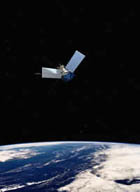NASA launches sister satellites on climate research
NASA on Friday launched two research satellites to help scientists refine computer models that forecast the weather and chart global climate change.

CloudSat and CALIPSO blasted off aboard an unmanned Delta rocket from Vandenberg Air Force Base in California at 6:02 a.m. EDT (1002 GMT) after a week of delays for weather and technical issues. The Boeing-built booster originally had been slated to fly last year, but a machinists' strike forced several months of delays.
CloudSat has powerful radar instruments to peer deep into the structure of clouds and map their water content. Although only about 1 percent of Earth's water is held in clouds, it plays a crucial role in the planet's weather, scientists working on the mission said.
"CloudSat will answer basic questions about how rain and snow are produced by clouds, how rain and snow are distributed worldwide, and how clouds affect the Earth's climate," principal investigator Graeme Stephens of Colorado State University said, reports reuters.
Col. Jack Weinstein, 30th Space Wing commander, was the spacelift commander for this mission, or final go-for-launch authority. Chuck Dovale was NASA’s launch manager, for the mission.
"This was our third launch this month and it is a testament to the tremendous team effort between NASA, the 30th Space Wing and our industry partners," Colonel Weinstein said. "We have one opportunity to be successful with each launch so 100 percent mission success is our standard."
The primary role of the 6,248-pound spacecraft is to gather information about the Earth’s water cycle. Together, CALIPSO and CloudSat will provide new perspectives on Earth’s clouds and aerosols, answering questions about how they form, evolve and affect water supply, climate, weather and air quality.
The Delta II is an expendable launch, medium-lift vehicle. It carries civil and commercial payloads into low-earth, polar, geosynchronous transfer and stationary orbits, informs Blackanthem.
The two satellites are the first Earth- or space-based instruments capable of viewing cloud layers and analyzing possible effects of the moisture and airborne particles within them on global weather and long-term climate patterns.
CloudSat and CALIPSO were originally slated to lift off in midsummer last year, but technical problems followed by a prolonged strike by Boeing aerospace workers and delayed their launch until April 21. A variety of communications, logistical and weather glitches scrubbed successive launch attempts for another week, reports Xinhua.
O.Ch.
Subscribe to Pravda.Ru Telegram channel, Facebook, RSS!


